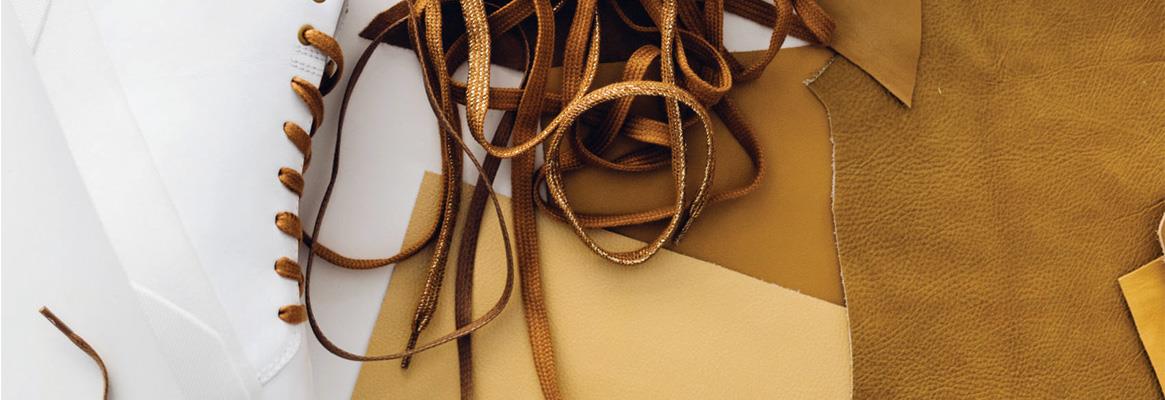Virtually nothinghas been hand-made in Germany for years. But increasingly, small companies areseeing the hand-made as an opportunity. Regina Henkel writes about the premiumVOR shoes label.
The hand-made in the German fashion industry has beendying-for decades. All clothing, shoes and accessories are now produced in Asiaor Eastern Europe, and knowledge about handcrafted production has largely beenlost. But not the appreciation of manual work, certainly not as yet. That's whymore small companies are recognising this as an opportunity.
Take the instance of VOR, a sneaker label from Munich thathas its exquisite shoes manufactured exclusively at a manufactory in the Germanshoe town of Pirmasens. Andreas Klingseisen and J�rg RohwerKahlmann have knowneach other since childhood. They had always been sneaker fans, and had the ideato establish their own sneaker label VOR to realise their own ideas.
Rohwer-Kahlmann had worked as a designer at Puma for sevenyears, and knew what he was getting into and what was important to him abouthis own label. "We wanted to make absolutely beautiful and goodshoes," says Rohwer-Kahlmann. A common dream was soon to come true.
In 2010, the two started their own business with VOR.First, they had their exclusive sneakers produced in Vietnam, and then inItaly. But with a quantity of only 500 pairs, VOR was not exactly a premiumcustomer-production was inevitably delayed and VOR got into difficulties withthe delivery dates. And, nowhere was the quality right. So, the search went onuntil in 2014 when the two bumped into Bernd Hummel in Pirmasens. The Germancity had had a long tradition in shoe production, and Hummel was none otherthan the Europe-wide licencee of Kangaroos and owner of the shoe manufactoryHummel & Hummel. He had just taken over an insolvent shoe manufactory, andwas looking for brands that appreciated being Made in Germany.
"It was a new start for both of us," saysRohwer-Kahlmann, "just as it was for the manufactory." The changeoverwas anything but smooth. Suddenly, they had to take care of everythingthemselves; there was no network of suppliers like in Asia or Italy. Everyeyelet, every shoelace, every sole, every upper-leather and every liningleatherhad to be searched for and found. Nothing at VOR comes off the rack; everydetail is deliberately chosen, even if you don't see it at all, like thelining-leather of the shoes. Normally, the liningleather is only available intwo or three colours, but VOR had a different colour in mind and took a long timeto find out the right manufacturer.
"There were times," says Rohwer-Kahlmann,"when we thought it would fail because of an eyelet!" It was not easyto convince suppliers to deliver exactly the quality that VOR wanted.Especially, if one could not promise large quantities. The conversion ofproduction to the Pirmasens location cost VOR almost a year of productiondowntime.
But, for the two foundersanother way would not have been the right one. "We needed this time,"says Klingeisen, "and that's exactly what VOR is all about".
 VOR sees itself as slow fashion.
You can tell by the model name. There is the model 1A, 1B and so on. Most
models are available in a small colour range and in different ankle heights.
Seasons and trends don't play a role. A new model comes out when it is ready,
not when the change of season demands it. What they all have in common is that
their design is reduced to the bare essentials. Says Rohwer-Kahlmann: "Our
shoes are exclusively made the way we want them to be. According to our design
ideas, with the best materials, without compromises." In the end, the
finished shoe consists of 40-50 parts and goes through many hands in the course
of its creation. After all these years, the design is still a co-production
between the two. Once a design has been determined, a prototype is created,
which is then worn and tested extensively. Customers appreciate the
meticulousness and come from the most different circles. They are between 20
and 80+ years old, the two entrepreneurs know.
VOR sees itself as slow fashion.
You can tell by the model name. There is the model 1A, 1B and so on. Most
models are available in a small colour range and in different ankle heights.
Seasons and trends don't play a role. A new model comes out when it is ready,
not when the change of season demands it. What they all have in common is that
their design is reduced to the bare essentials. Says Rohwer-Kahlmann: "Our
shoes are exclusively made the way we want them to be. According to our design
ideas, with the best materials, without compromises." In the end, the
finished shoe consists of 40-50 parts and goes through many hands in the course
of its creation. After all these years, the design is still a co-production
between the two. Once a design has been determined, a prototype is created,
which is then worn and tested extensively. Customers appreciate the
meticulousness and come from the most different circles. They are between 20
and 80+ years old, the two entrepreneurs know.
Meanwhile, the enterprise keeps growing. The minimalist VOR Sneakers sell well in fashion stores and sneaker shops, which can sell shoes from �340 to men and women. Most retailers are in Germany, followed by Switzerland, South Korea, Japan and Hong Kong. About one-third of the customers buy directly via the webshop and come from all over the world. From 500 pairs of shoes in the first year, VOR now has 4,000. Almost every year the turnover doubles. The next big step: VOR is currently moving to new premises in Munich, where the office, showroom and shop will stay united under one roof.








Comments